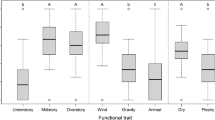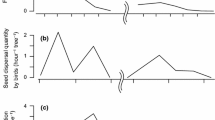Abstract
Seed dispersal patterns were studied in a north-western Spain temperate forest community to assess the performances of alternative dispersal kernels during two years with ecologically contrasting scenarios; a non-mast year, and a mast year of the dominant canopy species, beech Fagus sylvatica. Dispersal kernels were fitted under a Bayesian modeling framework. Both simple and mixture kernels were considered for the five more abundant tree species (Corylus avellana, Crataegus monogyna, F. sylvatica, Ilex aquifolium and Taxus baccata). Mixture kernels provided a better fit for almost all species, and the log-normal performed best for T. baccata. No relationship between dispersal syndromes and the best dispersal kernel function emerged. However, we found temporal changes in the shape of the dispersal kernels that seemed to be related to variation in relative fruit production among species and the resulting changes in the responses of dispersal vectors. This reveals a potential role for disperser-mediated indirect effects in terms of introducing temporal variation in species spread. In this sense, our results highlight the need to consider single species seed dispersal as a community process.




Similar content being viewed by others
References
Brooks SP, Gelman A (1998) Alternative methods for monitoring convergence of iterative simulations. JCGS 7:434–455
Bullock JM, Clarke RT (2000) Long distance seed dispersal by wind: measuring and modelling the tail of the curve. Oecologia 124:506–521. doi:10.1007/PL00008876
Burnham KP, Anderson DR (2002) Model selection and multimodel inference: a practical information-theoretic approach, 2nd edn. Springer, New York
Canham CD, Uriarte M (2006) Analysis of neighborhood dynamics of forest ecosystems using likelihood methods and modeling. Ecol Appl 16:62–73. doi:10.1890/04-0657
Clark JS, Macklin E, Wood L (1998a) Stages and spatial scales of recruitment limitation in southern Appalachian forests. Ecol Monogr 68:213–235. doi:10.2307/2657201
Clark JS, Fastie C, Hurtt G, Jackson ST, Johnson C, King GA, Lewis M, Lynch J, Pacala S, Prentice C, Schupp EW, Webb T III, Wyckoff P (1998b) Reid’s paradox of rapid plant migration. Bioscience 48:13–24. doi:10.2307/1313224
Clark JS, Silman M, Kern R, Macklin E, Hille Ris Lambers J (1999a) Seed dispersal near and far: patterns across temperate and tropical forests. Ecology 80:1475–1494. doi:10.2307/176541
Clark JS, Beckage B, Camill P, Cleveland B, Hille Ris Lambers J, Lichter J, McLachlan J, Mohan J, Wyckoff P (1999b) Interpreting recruitment limitation in forests. Am J Bot 86:1–16. doi:10.2307/2656950
Clark JS, LaDeau S, Ibañez I (2004) Fecundity of trees and the colonization-competition hypothesis. Ecol Monogr 73:415–442. doi:10.1890/02-4093
Clark JS, LaDeau S (2006) Synthesizing ecological experiments and observational data with hierarchical Bayes. In: Clark JS, Gelfand AE (eds) Hierarchical modelling for the environmental sciences. Statistical methods and applications. Oxford University Press, Oxford, pp 41–58
Connell JH (1971) On the role of natural enemies in preventing competitive exclusion in some marine animals and in rain forest trees. In: den Boer PJ, Gradwell OR (eds) Dynamics of populations. PUDOC, Wageningen
Dalling JW, Muller-Landau HC, Wright SJ, Hubbell SP (2002) Role of dispersal in the recruitment limitation of neotropical pioneer species. J Ecol 90:714–727. doi:10.1046/j.1365-2745.2002.00706.x
García D, Obeso JR, Martínez I (2005) Rodent seed predation promotes differential seedling recruitment among bird-dispersed trees in temperate secondary forests. Oecologia 144:435–446. doi:10.1007/s00442-005-0103-7
García D, Martínez I, Obeso JR (2006) Seed transfer among bird-dispersed trees and its consequences for post-dispersal seed fate. Basic Appl Ecol 8:533–543. doi:10.1016/j.baae.2006.11.02
Gelman A, Rubin DB (1992) Inference from iterative simulation using multiple sequences (with discussion). Statist Sci 7:457–511
Gilks WR, Roberts GO, Sahu SK (1998) Adaptive Markov Chain Monte Carlo through regeneration. J Am Stat Assoc 93:1045–1054
Gómez JM (2003) Spatial patterns in long-distance dispersal of Quercus ilex acorns by jays in a heterogeneous landscape. Ecography 26:573–584. doi:10.1034/j.1600-0587.2003.03586.x
Greene DF, Calogeropoulos C (2002) Measuring and modelling seed dispersal of terrestrial plants. In: Bullock J, Kenward R, Hails R (eds) Dispersal ecology. Blackwell Press, Oxford, pp 3–23
Greene DF, Canham CD, Coates KD, Lepage PT (2004) An evaluation of alternative dispersal functions for trees. J Ecol 92:758–766. doi:10.1111/j.0022-0477.2004.00921.x
Herrera CM, Jordano P, Guitian J, Traveset A (1998) Annual variability in seed production by woody plants and the masting concept: reassessment of principles and relationship to pollination and seed dispersal. Am Nat 152:576–594. doi:10.1086/286191
Herrera CM (2002) Seed dispersal by vertebrates. In: Herrera CM, Pellmyr O (eds) Plant–animal interactions. An evolutionary approach. Blackwell Publishing, Oxford, pp 185–208
Higgins SI, Richardson DM (1999) Predicting plant migration rates in a changing world: the role of long-distance dispersal. Am Nat 153:464–475. doi:10.1086/303193
Higgins SI, Nathan R, Cain ML (2003) Are long-distance dispersal events in plants usually caused by nonstandard means of dispersal? Ecology 84:1945–1956. doi:10.1890/01-0616
Hoppes WG (1987) Pre- and post-foraging movements of frugivorous birds in an eastern deciduous forest woodland, USA. Oikos 49:281–290. doi:10.2307/3565762
Hulme PE, Beckman CW (2002) Granivory. In: Herrera CM, Pellmyr O (eds) Plant–animal interactions. An evolutionary approach. Blackwell Publishing, Oxford, pp 132–154
Hurtt GC, Pacala SW (1995) The consequences of recruitment limitation: reconciling chance, history and competitive differences among plants. J Theor Biol 176:1–12. doi:10.1006/jtbi.1995.0170
Ibañez I, Clark JS, LaDeau S, Hille Ris Lambers J (2007) Exploiting temporal variability to understand tree recruitment response to climate change. Ecol Monogr 77:163–177. doi:10.1890/06-1097
Janzen DH (1970) Herbivores and the number of tree species in tropical forests. Am Nat 104:501–528
Jeltsch F, Moloney KA, Schurr FM, Köchy M, Schwager M (2008) The state of plant population modeling in light of environmental change. PPEES 9:171–189. doi:10.1016/j.ppees.2007.11.004
Jongejans E, Skarpaas O, Shea K (2008) Dispersal, demography and spatial population models for conservation and control management. Perspect Plant Ecol Evol Syst 9:153–170. doi:10.1016/j.ppees.2007.09.005
Jordano P, Schupp EW (2000) Seed disperser effectiveness: the quantity component and patterns of seed rain for Prunus mahaleb. Ecol Monogr 70:591–615. doi:10.2307/2657187
Jump AS, Hunt JM, Peñuelas J (2006) Rapid climate change-related growth decline at the southern range edge of Fagus sylvatica. Global Change Biol 12:2163–2174. doi:10.1111/j.1365-2486.2006.01250.x
Kot M, Lewis MA, van den Driesche P (1996) Dispersal data and the spread of invading organisms. Ecology 77:2027–2042. doi:10.2307/2265698
Lange N, Carlin BP, Gelfand AE (1992) Hierarchical Bayes models for the progression of HIV infection using longitudinal CD4 T-cell numbers (with discussion). J Am Stat Assoc 87:615–626
Lepage PT, Canham CD, Coates KD, Bartemucci P (2000) Seed abundance versus substrate limitation of seedling recruitment in northern temperate forests of British Columbia. Can J For Res 30:415–427. doi:10.1139/cjfr-30-3-415
Levin SA, Muller-Landau HC, Nathan R, Chave J (2003) The ecology and evolution of seed dispersal: a theoretical perspective. Annu Rev Ecol Evol Syst 34:535–604. doi:10.1146/annurev.ecolsys.34.011802.132428
Levine JM, Murrell DJ (2003) The community-level consequences of seed dispersal patterns. Annu Rev Ecol Evol Syst 34:549–574. doi:10.1146/annurev.ecolsys.34.011802.132400
Martínez I, García D, Obeso JR (2008) Differential seed dispersal patterns generated by a common assemblage of vertebrate frugivores in three fleshy-fruited trees. Ecoscience 15(2):189–199. doi:10.2980/15-2-3096
Martínez I, Wiegand T, Taboada FG, Obeso JR. Spatial associations among tree species in a temperate forest community in Spain (in preparation)
McLachlan JS, Clark JS, Manos PS (2005) Molecular indicators of tree migration capacity under rapid climate change. Ecology 86:2088–2098. doi:10.1890/04-1036
Moorcroft PR, Pacala SW, Lewis MA (2006) Potential role of natural enemies during tree range expansions following climate change. J Theor Ecol 241:601–616. doi:10.1016/j.jtbi.2005.12.019
Morales JM, Carlo TA (2006) The effects of plant distribution and frugivore density on the scale and shape of dispersal kernels. Ecology 87:1489–1496. doi:10.1890/0012-9658
Muller-Landau HC, Wright SJ, Calderón O, Hubbell SP, Foster RB (2002) Assessing recruitment limitation: concepts, methods and case-studies from a tropical forest. In: Levey DJ, Silva WR, Galetti M (eds) Seed dispersal and frugivory: ecology, evolution and conservation. CABI, New York, pp 35–52
Muller-Landau HC, Wright SJ, Calderón O, Condit R, Hubbell SP (2008) Interspecific variation in primary seed dispersal in a tropical forest. J Ecol 96:653–667. doi:10.1111/j.1365-2745.2008.01399.x
Nathan R, Muller-Landau HC (2000) Spatial patterns of seed dispersal, their determinants and consequences for recruitment. Trends Ecol Evol 15:278–285. doi:10.1016/S0169-5347(00)01874-7
Peñuelas J, Ogaya R, Boada M, Jump AS (2007) Migration, invasion and decline: changes in recruitment and forest structure in a warming-linked shift of European beech forest in Catalonia (NE Spain). Ecography 30:829–837. doi:10.1111/j.2007.0906-7590.05247.x
Piovesan G, Adams JM (2001) Masting behaviour in beech: linking reproduction and climatic variation. Can J Bot 79:1039–1047. doi:10.1139/cjb-79-9-1039
Ribbens E, Silander JA, Pacala SW (1994) Seedling recruitment in forests: calibrating models to predict patterns of tree seedling dispersion. Ecology 75:1794–1806. doi:10.2307/1939638
Robert CP, Casella G (2004) Monte Carlo statistical methods, 2nd edn. Springer, New York
Russo SE, Portnoy S, Augspurger CK (2006) Incorporating animal behavior into seed dispersal models: implications for seed shadows. Ecology 87:3160–3174. doi:10.1890/0012-9658
Sagnard F, Pichot C, Dreyfus P, Jordano P, Fady B (2007) Modelling seed dispersal to predict seedling recruitment: recolonization dynamics in a plantation forest. Ecol Model. doi:10.1016/j.ecolmodel.2006.12.008
Snow B, Snow D (1988) Birds and berries. T & AD Poyser, Carlton
Spielgelhalter DJ, Best NG, Carlin BP, van der Linde A (2002) Bayesian measures of model complexity and fit (with discussion). J R Stat Soc B 64:583–639. doi:10.1111/1467-9868.00353
Staelens J, Nachtergale L, Luyssaert S, Lust N (2003) A model of wind-influenced leaf litterfall in a mixed hardwood forest. Can J For Res 33:201–209. doi:10.1139/x02-174
Stoyan D, Wagner S (2001) Estimating the fruit dispersion of anemochorous forest trees. Ecol Model 145:35–47. doi:10.1016/S0304-3800(01)00385-4
Tilman D, Kareiva P (1997) Spatial ecology: the role of space in population dynamics and interspecific interactions (Monographs in Population Biology, vol 30). Princeton University Press, Princeton
Turchin P (1998) Quantitative analysis of movement. Sinauer, Sunderland
Uriarte M, Canham CD, Thompson J, Zimmerman JK, Brokaw N (2005) Seedling recruitment in a hurricane-driven tropical forest: light limitation, density-dependence and the spatial distribution of parent trees. J Ecol 93:291–304. doi:10.1111/j.0022-0477.2005.00984.x
van der Pijl L (1982) Principles of dispersal in higher plants, 3rd edn. Springer, Berlin
Wada N, Ribbens E (1997) Japanese maple (Acer palmatum var. matsumurae, Aceraceae) recruitment patterns: seeds, seedlings, and saplings in relation to conspecific adult neighbors. Am J Bot 84:1294–1300
Acknowledgments
Bea Blanco, Chus Oliveros and Xurde Sánchez helped with tree mapping, and Alicia Valdés assisted us with the lab work. Deborah Connolly revised the English. Comments by Eric Ribbens and an anonymous referee greatly improved the quality of this manuscript. E. Ribbens improved our writing style and provided many interesting suggestions and ideas that are especially acknowledged. Advice and comments by the associate editor John Silander were also useful and greatly appreciated. IM was supported by a PFPU grant (MEC), the project [CGL2004-2936/MEC], and a postdoctoral contract from the UFZ Department of Ecological Modelling; and FGT was supported by a FICYT “Severo Ochoa” grant (PCTI 2006-2009, Gobierno del Principado de Asturias). Both thank the COSTAS project [CTM2006-05588/MAR], which provided support in terms of a Dell Precision Workstation on which all of the simulations were run. This work was carried out in accordance with the laws of Spain.
Author information
Authors and Affiliations
Corresponding author
Additional information
Communicated by John Silander.
Electronic supplementary material
Below is the link to the electronic supplementary material.
Rights and permissions
About this article
Cite this article
Martínez, I., González-Taboada, F. Seed dispersal patterns in a temperate forest during a mast event: performance of alternative dispersal kernels. Oecologia 159, 389–400 (2009). https://doi.org/10.1007/s00442-008-1218-4
Received:
Accepted:
Published:
Issue Date:
DOI: https://doi.org/10.1007/s00442-008-1218-4




